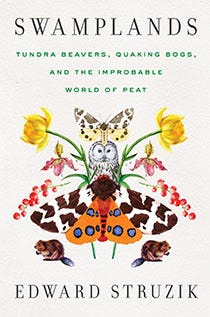Swamplands: Tundra Beavers, Quaking Bogs, and the Improbable World of Peat by Edward Struzik
A Book Review
Swamplands: Tundra Beavers, Quaking Bogs, and the Improbable World of Peat by Edward Struzik. Island Press 2021. 296pp
We all love the beauty of pine forests, and we will go to great lengths to walk among cedars and ponderosa. Other landscapes attract us or capture our imaginations as well. We find inspiration in the austere drama of deserts and steppes. We appreciate the friendly familiarity of oak woodlands.
But we don’t cotton to swamps and bogs. And we’re uncomfortable with fens and marshes for that matter. They are in-between lands that are too soggy for a good hike and too shallow for a good swim. For centuries they have been thought of as nether lands, portals to unearthly realms, and sources of “bad air,” which was believed to bring devastating diseases like cholera. When European explorers of the New World came across soggy peatlands, they described them as “sterile and “barren.” Farmers in Wales have a word for these wetlands, “MAMBA,” which stands for “miles and miles of bugger-all,” which probably gives you a good indication as to how much those folks appreciate peatlands.
Science and environmental writer Edward Struzik wants to rid our minds of these prejudices that we have of these waterlogged landscapes, and with his recent book, Swamplands: Tundra Beavers, Quaking Bogs, and the Improbable World of Peat, he does a commendable job of sharing his wonder and appreciation of these remarkable places.
He writes well, as someone with more than 30 years experience and multiple awards should. (Among his endeavors, he spent a year at Harvard and MIT with E.O. Wilson, Stephen Jay Gould and Richard Lewontin researching environment, evolutionary biology, as well as politics.) The style is casual without being too breezy.
With each chapter, Struzik takes us to a different locale—Hawaii, Florida, New York City, western Canada, even, difficult as it is to believe, below sea level in the Mojave Desert—and from there relates some of his personal experiences with the geography, the plants and animals he sees or has seen, as well as his interactions with some of the scientists who study the flora and fauna that live among the peatlands.
Intermixed are great dollops of history. Of the Great Dismal Swamp in Virginia and North Carolina, he recounts the first white settlers and their experience of the swamp; how the swamp was used as a haven by escaped slaves in the 18th and 19th centuries; and how so many people for so long have been hell bent on draining the Great Dismal. The Cold War and its legacy of atomic bombs enter the narrative of the lowlands of the Hudson Bay, and Struzik includes some little-known and jaw-dropping facts from that time.
Each chapter has its stories of the abuse the wetlands have endured at our hands. Bogs and fens are drained to convert them to farmland, or they are encroached upon by roadways and places like Busch Gardens. More than once Struzik recounts how peatlands were used as artillery practice ranges or were otherwise bombed or degraded. Still, there are the moments of wonder, as when Struzik discovers a rare pitcher plant or spends a night with an entomologist finding beautiful species of moths. And there are successes. Conservationists sometimes win their battles, or just as often it seems, folks lose interest in draining or running a road through a swamp or bog.
Along the way, Struzik recounts a few of his times enduring thunderstorms, a couple encounters with grizzly bears, and other dangers and wonders that he has experienced in the outdoors. These passages are some of the most vivid and enjoyable sections of the book. We also meet interesting folks like Fran Gilmar, a spry 77-year-old who isn’t afraid to shoo away obnoxious off-roaders or to tell the coal companies that they can’t despoil the lands around her corner of western Canada. And there is more than one eccentric and interesting scientist to be found in these pages.
We learn of quaking bogs, blanket bogs, and pingos, mounds of ice that form in northern latitudes thanks to the insulating character of peat. We also learn about the character of peat, the undecomposed organic matter that accumulates in these inundated lands. I would have appreciated a bit of a primer on the distinctions among these wetlands, i.e. what distinguishes a bog from a fen from a swamp. (I’ve actually studied this, at least casually through my own interest, and I must confess that I can still be confused by the what differentiates a bog from a fen.)
Swamplands is a welcome book, in part because there is just such a dearth of literature on the subject. Your local librarian may not have much to offer when you tell him that you’re looking for a book on swamps. Tell him you’re wanting to read up on fens, and you will probably get raised eyebrows and a big “What?” But you could make it easy on him and just ask for Edward Struzik’s Swamplands.
For more environmental science and news follow me on Twitter @EcoScripsit.






Sounds right up my alley. Thanks for this, Paul!